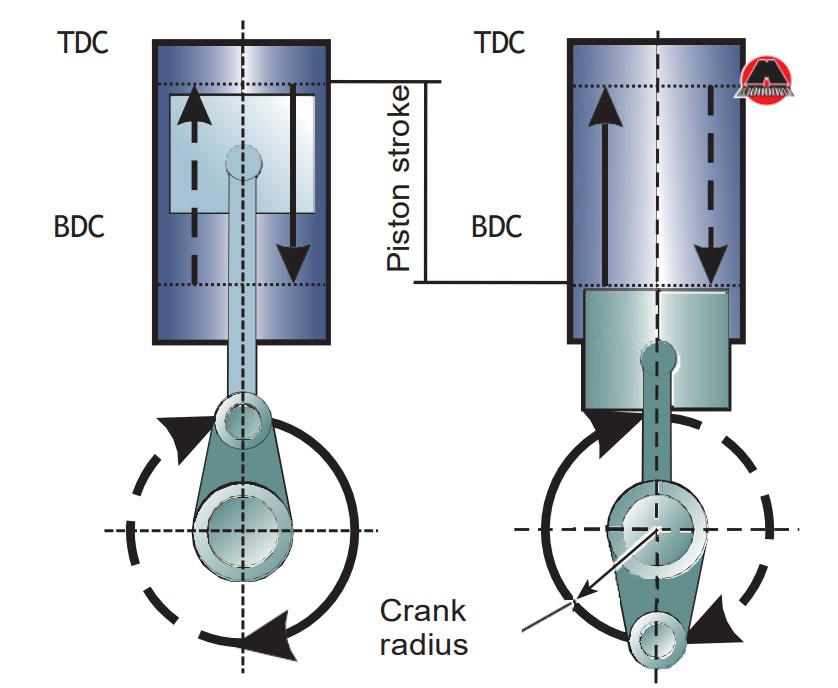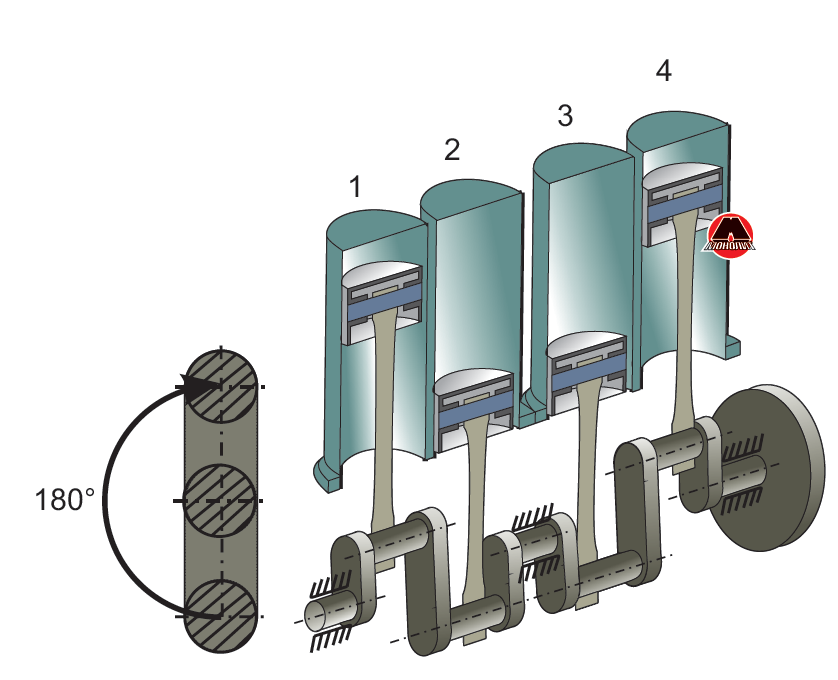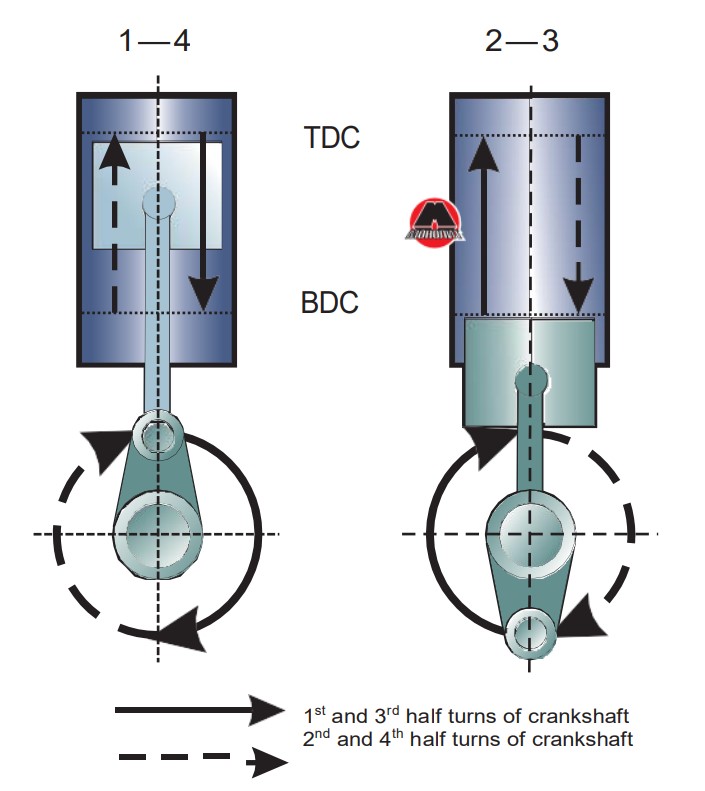4.4.1 Technical specifications
One can get an idea about any engine if a set of certain technical parameters is known.


One can get an idea about any engine if a set of certain technical parameters is known.
User comments (2)
Cylinder diameter. This refers to the inner diameter of the cylinder, which is usually measured at several points and calculated as the arithmetic mean of the data obtained.
User comments (1)
Piston stroke. This is the distance, which the piston travels from TDC to BDC. It is also equal to twice the radius of the crank.
Note
Usually, when describing the technical characteristics of the engine, the cylinder diameter and the piston stroke are recorded together, using the "x" symbol, for example, 95˟85 mm. In case if the piston stroke exceeds the cylinder diameter, the engine is called long-stroke, if on the contrary – it is called short-stroke.
 Figure 4.4 Piston stroke.
Figure 4.4 Piston stroke.
User comments (5)
Crank radius. The distance at which the rod journal (the one to which the connecting rod is attached) is retracted from the axis of the main journal of the crankshaft, as shown in Figure 4.4.
User comments (2)
Engine capacity. This is the volume of space, which is enclosed between TDC and BDC of the piston, multiplied by the number of cylinders. It is measured in cubic centimeters (cm3 ) or liters (l). And the volume, which is above the piston when it is installed in TDC, is called the volume of the combustion chamber. The sum of the volume of the combustion chamber and the working chamber is called the total volume. Usually, this total volume is not indicated in the characteristics. However, it is used for obtaining such an important parameter as the compression ratio.
User comments (0)
Compression ratio. This is the ratio between the total volume of the cylinder and the volume of the combustion chamber. This parameter characterizes how many times the air-fuel mixture is compressed in the cylinder. It is usually indicated in the form of a ratio, for example 14:1 (in this case, it means that the volume of the combustion chamber is 14 times less than the total volume). The compression ratio affects the efficiency and power of the engine: the higher is this ratio, the more efficient it is. But there are also limitations due to the characteristics of the fuel used (see below in the section "Feed System of Modern Engines").
Note
In case of the gasoline engine it is impossible to infinitely increase the degree of compression, because this increases the likelihood of knocking of the air-fuel mixture and, as a result, the failure of the entire engine. Knocking will be described in more detail below.
User comments (1)
In-line engine. This is designation of the relative position of the cylinders. The engine can be in-line, V-type, W-type.
 Figure 4.5. Different options of relative positions of cylinders.
Figure 4.5. Different options of relative positions of cylinders.
User comments (1)
The order of the engine cylinders. In case if there are more than two cylinders in the engine, then for a more uniform and balanced operation of the unit, it is necessary that the working stroke in each of the cylinders is implemented not simultaneously, but in a certain sequence. While this sequence shall be mainly determined by the number of cylinders.
Note
For ICE with the same number of cylinders, there can be several options of the order of the engine cylinders.
So, for example, the most common order of the engine cylinders for a four-cylinder engine is: 1 - 3 - 4 - 2. Such a record suggests that first the working stroke will be made by the piston of the first cylinder, then the third, fourth and second, respectively. As an example, we will describe the operation of a four-cylinder inline engine.
 Figure 4.6 Schematic diagram of four-stroke, four cylinder in-line engine.
Figure 4.6 Schematic diagram of four-stroke, four cylinder in-line engine.
In a four-stroke, four cylinder in-line engine (shown in Figure 4.6), the crankshaft cranks are located in the same plane: two extreme cranks, 1st and 4th, at an angle of 180 ° to the two middle cranks - 2nd and 3rd. When the shaft rotates, the pistons of the first and fourth, as well as the second and third cylinders move in pairs in the same direction. When the pistons of the first and fourth cylinders come to TDC, the pistons of the second and third cylinders are in BDC, and vice versa. In each of the cylinders, the working cycle is completed in two revolutions of the crankshaft, and the alternation of strokes is selected in such a way that different strokes occur simultaneously in all cylinders. This ensures uniform rotation of the shaft. Let’s suppose that during the first half-turn of the shaft (from 0 ° to 180 °) in the first cylinder, the piston goes from TDC to BDC, and a working stroke occurs in it. Then, in the fourth cylinder, the piston also moves to the BDC, but the fuel mixture is injected. In the second and third cylinders, the pistons move to TDC, while the working mixture is compressed in the third cylinder, and exhaust gases are released in the second.
Note
The valve opening and closing moments are controlled by the camshaft (described in more detail below).
During the next three half-revolutions of the crankshaft the strokes in each of the cylinders will follow in the usual sequence for a four-stroke process.
By the time the shaft finishes the fourth half-turn, all the strokes of the working cycle have occurred in all cylinders. With further rotation of the shaft, the strokes will be repeated in the same sequence.
When a four-stroke four-cylinder engine is operating, there is one working stroke for each half-turn of the crankshaft, and the working strokes alternate not in the order of the cylinders, but in a different sequence. Firstly, the working stroke takes place in the first cylinder, then in the third, then in the fourth and, finally, in the second, that is, the working strokes alternate in the following order: 1 - 3 - 4 - 2.This order of alternating cylinder strokes is called the engine operating procedure.

Figure 4.7 Half turns of crankshaft.
With the same form of arrangement of the cranks of the shaft, but with a different order of opening and closing the valves, which depends on the design of the gas distribution mechanism, the four-cylinder engine may have a different sequence of alternating strokes and a different order of operation. In case if during the first half-turn of the shaft in the third cylinder there will be an exhaust stroke, and in the second - a compression stroke, then the alternation of strokes in the engine will change, and an operating order will be obtained: 1-2-4-3.
| Half turns of crankshaft
|
Angles of rotation of the crankshaft, °
|
Cylinders
|
|||
| 1 st
|
2 nd
|
3 rd
|
4 th
|
||
| 1 st
|
0 – 180 | Working stroke
|
Exhaust
|
Compression
|
Intake
|
| 2 nd
|
180 – 360 | Exhaust
|
Intake
|
Working stroke
|
Compression
|
| 3 rd
|
360 – 540 | Intake
|
Compression
|
Exhaust
|
Working stroke
|
| 4 th
|
540 – 720 | Compression
|
Working stroke
|
Intake
|
Exhaust
|
User comments (0)
Compression in the cylinder. The maximum pressure, which is created in the cylinder when the air is compressed by the piston. It is often measured in bars (bar), kilograms per square centimeters (kg/cm2 ) or megapascals (MPa). Intensity of compression is often confused with compression. However, one shall always remember that the intensity of compression is an exclusively geometric parameter, as opposed to compression.
User comments (0)
Engine power. Engine performance, which is done per unit of time. It is measured in horsepower (hp) or kilowatts (kW). In other words, power is a parameter that describes how fast an engine's crankshaft can turn. In order to better understand this, imagine that you are a cyclist and power is a measure of how fast you can spin the pedals.
User comments (0)
Torque. This is the product of force on the arm. For an internal combustion engine, this is the thrust, which is created on the crankshaft. In other words, this is the force with which the piston presses through the connecting rod on the crankshaft connecting rod, multiplied by the radius of the crank (see above). Let's go back to the cyclist to make it more clear. The amount of traction on the pedal axis depends both on the length of the pedal (shoulder) and on the force with which the cyclist presses on this pedal. The torque is measured in newton meters (Nm).
User comments (2)









Demonstration video
How to register on the site?
How to get a pro account?
How to use directories?
How to choose a category?
How to find out the expiration date of a pro account?
How to contact you?
How to add to the group to the teacher?
Do the questions on the site correspond to the official ones presented in the service center?
Frequently asked questions
To use all the features of the service, you must register. After registration, a personal account will be created for you in which you can monitor your progress, compete in knowledge with other students, as well as perform work on errors in a timely manner.
Pro-account advantage
- Access to 100% of questions and illustrations on the site, exactly corresponding to those that will be presented at the exam in the Service Center
- Using the resource without advertising
How do I activate a pro-account?
You can purchase a pro-account using this link.
What is a "Promocode" and where can I get it?
A promotional code for a discount when purchasing a Pro account can only be obtained from your teacher, if he is registered in our service.
In the exam mode, the same questions are repeated. Why?
The question matching algorithm works in accordance with the distribution scheme for a real exam at a service center. Repeated questions simply relate to topics in which there are few questions (for example: 7 topic (8 questions), 17 (8), 21 (8), 22 (6), 25 (8), etc.). Therefore, repetitions of these topics will occur much more often.
How is the service rating table formed?
There are two ranking tables in service. The first table is made based on the best time of passing a test. The second one is made based on the amount of gained scores. Scores are added for achievements in doing tests (correct answers, passing a test without mistakes, etc).
How are points awarded?
The correct answer in the "20 random questions" mode: +1 point.
Wrong answer in the "20 random questions" mode: -1 point.
The correct answer in the "Exam" mode: +2 points.
Wrong answer in the “Exam” mode: -2 points.
5 correct answers in a row in the "20 random questions" mode: +2 points.
5 correct answers in a row in the "Exam" mode: +3 points.
7 correct answers in a row in the "20 random questions" mode: +3 points.
7 correct answers in a row in the "Exam" mode: + 4 points.
10 correct answers in a row in the mode "20 random questions": +4 points.
10 correct answers in a row in the mode "Exam": +5 points.
15 correct answers in a row in the mode "20 random questions": +5 points.
15 correct answers in a row in the "Exam" mode: +6 points.
18 correct answers in a row in the mode "20 random questions": +6 points.
18 correct answers in a row in the mode "Exam": +7 points.
If, within the framework of one test, the correct answers are less than the wrong answers, the total for the test is 0 points.
The email does not receive a letter to activate the user
If you did not find this email in your inbox, please search for it in the “Spam” tab and note that this email is not spam.
If there is no letter and in spam, then use the feedback form, indicating the reason for the request: “The account is not activated”. Our specialists activate your account as soon as possible.
Site unavailable. What to do?
Most likely, your IP-address for some reason was blacklisted. Please send data to our email: info@green-way.com.ua. If you are unable to determine your IP address, write a message with the note “Learn IP” - and we will send a small instruction.
I found a mistake in the question. How to inform you?
Under each question is a comment system, where you can leave your message with a comment or a suggestion, and we, in turn, will respond promptly to it.
How to become a teacher?
If you are a driving school teacher, then you have the opportunity to monitor the performance of your study group with the help of our service. To use the unique features of the service, you must perform the following steps:
After that we will contact you to clarify details and activate the teacher’s account. Please send all questions, comments and suggestions to info@green-way.com.ua or call (097) 517-98-97 (Alexey).
How can a teacher add students to a group?
In your personal account in the tab “Teachers” you need to perform the following actions:
Master account
Free account for driving school teachers. It is provided automatically to each teacher confirmed by the site administration.
Become available:
The site does not work correctly
For the full and correct operation of the site should be enabled cookies. These are electronic information units that can be transferred to a user's hard disk to configure a product or website, store information about a user’s access to a website or product, and store information that a user regularly needs.
The message "Your account is used on another device" appears
If you use more than one device (computer, phone, tablet), then only one of them can be tested. If you simultaneously log in from multiple devices to others, you will be logged out of your account.
How can I delete my data from the site?
You can send a request to delete your data by writing an appeal to info@green-way.com.ua or using the "Feedback" form.
After confirmation of the application by the moderator, your data will be deleted.



To obtain a certificate, save progress and further study on our resource, we recommend log in or registering.



Our test questions are 100% compliant with the official ones, for which theoretical exams are taken in the service centers of Ukraine.
All other resources that claim that their test items are official, mislead you. The illustrations are modified and irrelevant text is placed in them. Preparing with the help of such resources, you can get confused on the official exam and simply do not pass it.